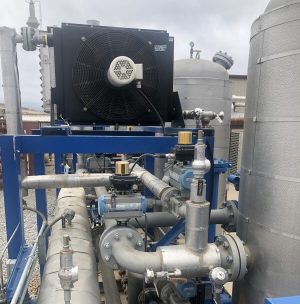According to the United States Environmental Protection Agency, Municipal Solid Waste (MSW) landfills account for about 14.1 percent of all human-related methane gas emissions in the United States. Methane gas is important to track because it is a major greenhouse gas that traps heat in Earth’s atmosphere. In fact, methane is 28-36 times more potent at trapping heat over a 100-year period than carbon dioxide.
With a rapidly growing worldwide population, the rate at which humans produce methane gas has little chance of slowing anytime soon. That means there is an increasingly urgent need to find ways to capture and use landfill gas (LFG) before it dissipates into the atmosphere. De-oxygenation units (AKA deoxo units) at gas compression facilities help do exactly that by converting LFG to renewable natural gas (RNG).
The LFG to RNG Conversion Process
Before LFG can escape into the air and add to pollution and climate change, it can be collected from landfills using piping, wells and a vacuum system. The first part of the process is referred to as the primary treatment, and it involves moisture removal through special equipment such as a knockout pot, filter, blower and flare.
The secondary treatment stage typically involves an aftercooler and/or compressor that removes additional moisture and impurities. An additional compressor may be used during the advanced treatment stage, which is the final step where remaining impurities such as CO2, N2, O2 and VOCs are removed. The end result is a high-BTU gas fit for use in vehicles or for transportation via pipeline.
Today, the goal of LFG conversion typically falls within one of three categories: electricity generation, direct use of fuel and renewable natural gas. Generating electricity is the most common outcome, encompassing about 72 percent of all current LFG operations.
Direct fuel use means the landfill gas is applied directly to a boiler, kiln or other thermal combustion equipment. Renewable natural gas is a high-BTU gas with lower CO2 and higher methane than the original emission. That makes it an excellent fossil fuel replacement and a useful energy source for a variety of thermal applications.
Importance of Heat Exchangers to Creating Renewable Energy
Industrial Radiator Service is proud to contribute to the operation of LFG to RNG conversion projects through our reliable heat exchanger and radiator products, which are used in gas compressors, aftercoolers and other methane processing equipment.
The basic purpose of a heat exchanger is to transfer heat from one fluid or gas to another, without the two fluids or gases mixing. The hot air passing through a compressor during the secondary or advanced treatment stages described earlier contains water vapor that must be removed before it enters a pipeline. Heat exchangers make this happen, so it’s important to make sure they’re well maintained.
Some of the benefits of RNG production are greater energy diversity and capacity, less greenhouse gas and harmful air particle emissions and the economic support of local industries and infrastructure. Visit our heat exchanger page for details about cooling system repair and service from Industrial Radiator Service, and check out the EPA Landfill Methane Outreach Program for more information about LFG to RNG conversion.
Contact us today to find the right solution for all you gas compressor heat exchanger and radiator needs.


